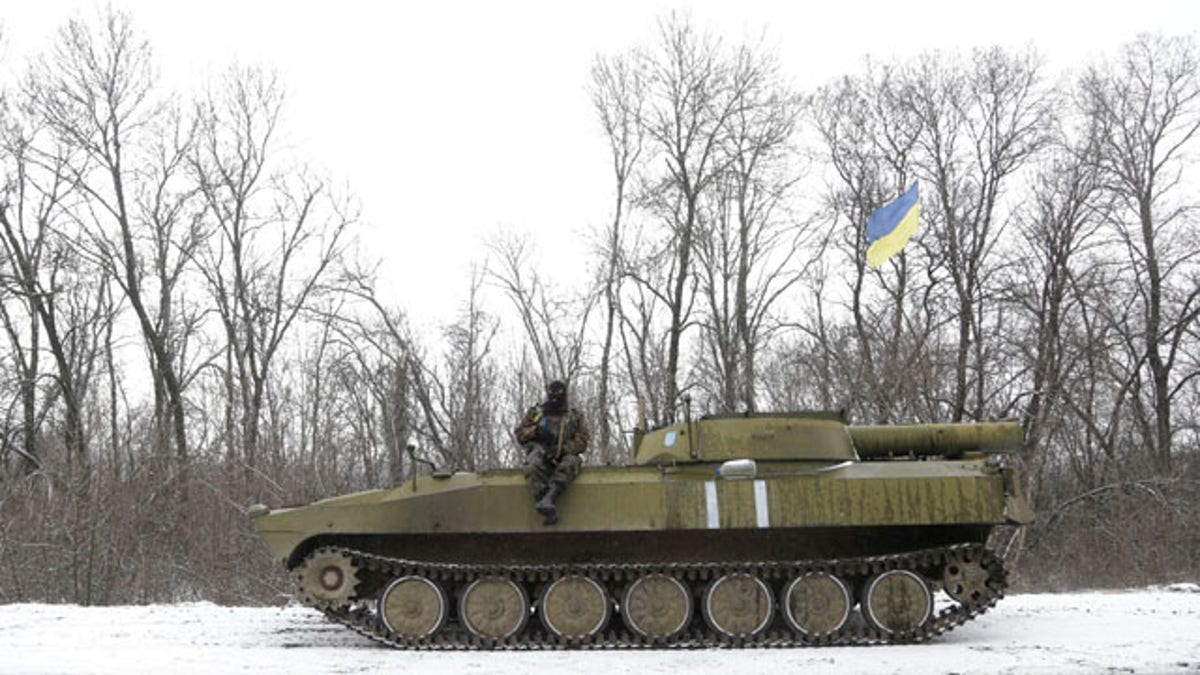
Feb. 16, 2015: An Ukrainian soldier rests on his vehicle near the road between the towns of Debaltseve and Artemivsk. (AP Photo/Petr David Josek)
With the second Minsk agreement, there was a small hope that further escalation in Ukraine could be avoided. And in spite of the attack on Debaltseve, there are still attempts to salvage this hope.
Medsanbat offers rigorous training, instruction and practical courses in international combat casualty care standards. Over 2,000 medical professionals and soldiers have undergone this training so far.
But, that said, it has become clear that the broad picture is bleak: The fragile nation state of Ukraine has been invaded and forced into a war. And, since no one has wanted to call it war, there has been no legitimate aid to help push back an invading Russia.
Medsanbat offers rigorous training, instruction and practical courses in international combat casualty care standards. Over 2,000 medical professionals and soldiers have undergone this training so far.
Thousands are dead on Europe’s doorstep. The post Cold War security world order has been trampled by belligerent aggression, based on an approach of outdated 19th Century big power politics.
Meanwhile, Ukrainian citizens have acted with absolute bravery. The volunteer surge may just provide the necessary resources to save their country.
Such support from society has been crucial. Not only has international support for those defending Ukraine been lacking, but Ukraine’s public infrastructure was not at all prepared for war. Ukraine never expected to be attacked – and its army, public health and emergency medicine systems were in a sorry state even before Russia’s advances.
At core, Ukraine was pulled into this conflict as a country that had just started its transition to a modern, democratic – and hopefully – Western nation.
Citizens on the Maidan achieved a victory in their fight against decades of Soviet led bureaucracy and corruption that crippled Ukraine’s infrastructure and governance. But just at that moment, the Kremlin pounced, embarking on a hybrid warfare assault to destabilize the country to prevent it from transforming successfully.
Ukraine has been forced to defend itself with an army and a health infrastructure inherited from the Soviet Union that was never properly reformed. As a result of this, people are dying, despite many of the cases being largely preventable.
Indeed, the medical evacuation chain is broken: Medevac helicopters have been shot down, mobile hospitals dating from the 1950s are in use, limited armored ambulances are used by the opponents for slow moving target practice, the emergency medic equipment is Soviet and most surgeons have limited experience in battlefield trauma.
Battlefield medicine is very specific and different from hospital and general emergency medicine. Ukrainians hoped to never have to learn or practice it.
In this respect, the World Health Organization has taken the lead, but its neutrality and its nature as a huge international organization, of course, means it has a certain focus in its operations and cannot do everything needed to build immediate capacity.
Instead, Ukraine has been forced to rely on the support of volunteers and philanthropists. I have gotten deep insights into this impressive movement during my work for the Medsanbat project, which was created by Ukrainian philanthropists Elena and Victor Pinchuk.
Medsanbat offers rigorous training, instruction and practical courses in international combat casualty care standards. Over 2,000 medical professionals and soldiers have undergone this training so far. And Medsanbat has handed out over 200 advanced combat medic bags to aid in the evacuation chain and prevent deaths where the Ministry of Defense is currently overwhelmed.
We have seen how the most basic equipment and training can prevent unnecessary death on a massive scale.
The simple use of a Combat Applied Tourniquet (CAT) to a hemorrhaging limb stops bleeding from rocket attacks and enemy sniper fire – it quite literally saves lives.
Combat gauze, when applied properly can stop bleeding in areas where CATs cannot be effectively applied. Two medics working on helicopters have described how this combat gauze is stuffed into neck and shoulder wounds, stopping the bleeding long enough to get the patient to surgery and save yet another life.
Sucking chest wounds are a common result of projectile trauma, especially considering the outdated and poorly graded body armor that Ukrainian warfighters are using. A bullet or piece of fragmentation from a rocket or explosion collapses the lung after it hits the chest. The emergency chest seal in the combat medic bag covers this hole and a long needle can be carefully inserted into the chest to relieve the air that is stuck in the wrong place. The patient can breathe again, and will live.
The combat medic program of Medsanbat is an example of how philanthropists can buttress governmental institutions in the short term. The program is in the process of being taken over by the Ministry of Defense and will, hopefully, live on well past the end of this conflict.
While the West is pondering if it should provide Ukraine with defensive weapons, as recommended by a recent Brookings Institution report, Ukraine’s soldiers will be on their own.
Ukraine and its citizens desire peace. But right now, they have no choice but to defend themselves. And they will do it alone if they have to.
After having stupefied the world with their tenacity on the Maidan, Ukrainians are showing that they are ready to sacrifice their lives to live in a society built on the principles of democracy, freedom and the rule of law.
Helping Ukrainians defend themselves against a powerful, and perfidiously disguised aggression is the least the West could do. Even limited support with know-how and equipment can make a big difference in this fight of David against Goliath, as I have seen during my work in Ukraine.
